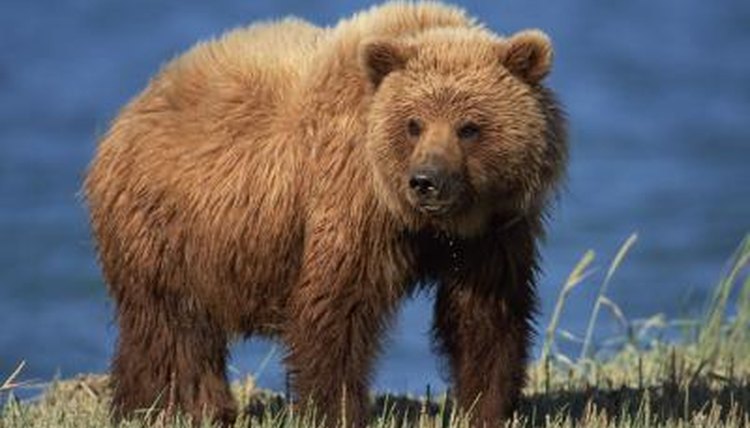
Brown bears are at the top of the food chain and have no predators. They will eat almost anything. They are omnivorous and will eat plants and other animals if available. Plants food are their main diet. What they eat depends on what kind of foods are available where they live and the particular season.
Brown bear is one of the largest bear species. It ranges in color from dark to reddish brown to cream toned. They resemble but are generally larger than the black bear. They have longer claws for their different feeding habits and a stronger body mass.
FACTS ABOUT BROWN BEAR
- Size: Length is 6 to 9 feet long for males. Females about 5 to 8 feet long.
- Weight: About 400 to 1200 pounds for males. Females weigh about 300 to 800 pounds. Weight depends on where they live and diet. Bears who eat lots of salmon put on weight quickly.
- World record brown bear: (see Grizzly Bear).
- Life span: Can live up to 25 years in the wild. Longer in captivity.
- Litter size: 1 to 4 cubs, pairs most common.
- Baby cub birth weight: 1 to 1.5 pounds.
- Maturity: 3 to 5 years
- Hibernation: Duration depends on habitat. Generally October through March. Hibernating brown bears can awaken if necessary.
- Behavior: Solitary except during mating season.
- Mating season: May to July are the usual breeding months.
- Threats: Human expansion, global warming, deforestation, hunting, poaching, territory fragmentation.
- Conservation status: Although not officially listed as an endangered species in the Unites States, their natural habitat is in fact under constant threat and on the decline.
- Fun fact: Brown bears can climb trees to eat or escape predators, but only when they are cubs! As they become adults they become too heavy for climbing.
There is only one brown bear species, but there are many subspecies. Depending on where they live brown bears are also known as the Alaskan, Grizzly, European, Syrian, and Kodiak brown bear.
Brown bears like to feed in the morning and evening to avoid the afternoon heat. They eat all summer long to gain weight for the winter months. They are very mobile and have been know to travel long distances to food sources.
They like grass, leaves, wild berries, nuts, seeds, fruits, bulbs and tubers. They will also snack on beetles, termite nests, worms, ants, and other insects. They will use the claws on their paws to scrape bark, turn over logs, and disturb dirt mounds to find bugs and other edibles.
If available brown bears will hunt for animal prey. They will eat rodents, squirrels, foxes, and other small animals. They have also been known to attack young deer and sheep.
Brown bears love fish and are fond of salmon. They are excellent at fishing. In fact each bear has its favorite spot and will try to “reserve” it from other bears. Mother bears bring their cubs to give them a teaching lesson.
WHERE DO BROWN BEARS LIVE?
Brown bears live in North America, Asia, and Europe. In North America their appearance and fur color varies depending on facts such as habitat, diet, season, etc. The state of Alaska contains 70 percent of the brown bear population in North America according to conservation records.
Brown bears are one of the more familiar bears since they are widely distributed compared to other species. Their preferred living areas vary from meadows and valleys to forests and mountains.
They will migrate to areas where food is abundant according to season. Over time their original environments have steeply declined as human populations rise.
BROWN BEAR CUB
As winter approaches the mother brown bear (a sow) will prepare her den. She will enter the den while pregnant and begin hibernation. While hibernating she will give birth to brown bear cubs between winter and early spring. In some warmer habitats hibernation may not occur.
Baby brown bears are usually born in pairs. They are born blind and without hair. The newborn cubs find their mother’s nipples and nurse with her until spring arrives. Mother and cubs then venture outside to explore their habitat and find food to eat. They will also learn survival skills.
Baby brown bears eat and grow rapidly. They will copy their mother’s methods for locating and hunting for food. They spend the next two and a half years living with her. At that time the cubs are ready to live on their own so the mother can breed and reproduce again





